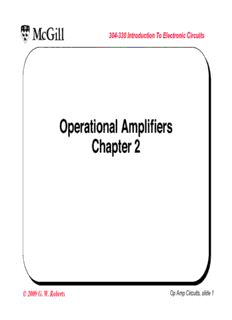
Op Amp Circuits PDF
Preview Op Amp Circuits
304-330 Introduction To Electronic Circuits Operational Amplifiers Chapter 2 © 2009 G. W. Roberts Op Amp Circuits, slide 1 304-330 Introduction To Electronic Circuits Outline • The Ideal Op Amp • The Inverting Configuration • The Noninverting Configuration • Difference Amplifiers • Integrators and Differentiators • DC Imperfections • Effects of Finite Open-Loop Gain and Bandwidth on Circuit Performance • Large-Signal Operation of Op Amps • Simulating Op Amp Circuits With SPICE • Summary © 2009 G. W. Roberts Op Amp Circuits, slide 2 304-330 Introduction To Electronic Circuits The Universal Analog Building Block: Main Terminals Three terminals shown plus power supply connections. Op amps have other terminals that is used to tuned its non-ideal behavior. The Op Amp Symbol C € C € (C) The op amp shown connected to dc power supplies (with noise decoupling capacitors). © 2009 G. W. Roberts Op Amp Circuits, slide 3 304-330 Introduction To Electronic Circuits Electrical Equivalent Op Amp Circuit v out = f(v ,v ) 1 2 = • Input/Output Impedance: v v v Z− = 1 = ∞ Z+ = 2 = ∞ Z = o = 0 in i in i out i v −v =K 1 2 o 1 2 i =i o x Output impedance is derived by setting the input sources to some constant value, and a current into the output port and deriving the corresponding output voltage. € © 2009 G. W. Roberts Op Amp Circuits, slide 4 304-330 Introduction To Electronic Circuits Electrical Equivalent Op Amp Circuit Av + A v 1 1 2 2 = € • One output, two inputs: ( ) v = f v ,v out 1 2 – If circuit is linear, then v = A v + A v € out 2 2 1 1 © 2009 G. W. Roberts Op Amp Circuits, slide 5 € 304-330 Introduction To Electronic Circuits Equivalent Signal Representation: CM and DM Signals v Node voltages: 1 v v = v − I,d 1 I,cm 2 v v = v + I,d 2 I,cm 2 Solving For CM & DM signals: v 2 v + v € v = 1 2 I,cm 2 v = v − v I,d 2 1 • Any two node voltages (relative to analog ground) can be expressed as a linear combination of their € corresponding DM & CM signal components. © 2009 G. W. Roberts Op Amp Circuits, slide 6 304-330 Introduction To Electronic Circuits Creating The Differential Source Arrangement Av + A v 1 1 2 2 € • Op Amp circuits must be driven with the source arrangement shown here. © 2009 G. W. Roberts Op Amp Circuits, slide 7 304-330 Introduction To Electronic Circuits Creating The Differential Source Arrangement Av + A v 1 1 2 2 € 1 v =A v +A v =(A +A )v + (A −A )v out 2 2 1 1 v1=vI,cm−vI,d 2 1 2 I,cm 2 1 2 I,d v =v +v 2 2 I,cm I,d • By design, A = -A = A: Amplification depends 1 2 only on the DM signal ( ) v = 0⋅v + A ⋅v = A v − v and not the CM signal out I,cm 1 I,d 2 1 © 2009 G. W. Roberts Op Amp Circuits, slide 8 € 304-330 Introduction To Electronic Circuits Creating The Differential Source Arrangement v = Av + A v out 1 1 2 2 ( ) ( ) = A v − v 2 + A v + v 2 1 I,cm I,d 2 I,cm I,d 1 ( ) ( ) = A + A v + A − A v Av + A v 1 1 2 2 1 2 I,cm 2 2 1 I,d By design, A = -A : € 1 2 € ( ) v = 0⋅v + A ⋅v = A v − v out I,cm 2 I,d 2 2 1 Amplification depends only on the DM and not the CM signal: € A 2-input system becomes a 1-input system. © 2009 G. W. Roberts Op Amp Circuits, slide 9 304-330 Introduction To Electronic Circuits Op Amp Internal Architecture • Example: Calculate the output voltage as a function of the input v and v using the 1 2 following parameters: mA G =10 , R =10 kΩ, µ=100 m V • Solution: € v V A = o = −µG R = −104 1 v m V 1 v =0 2 v V A = o = µG R =104 2 v m V 2 v =0 1 V ∴v =104(v − v ) O 2 1 V € © 2009 G. W. Roberts Op Amp Circuits, slide 10 €
Description: